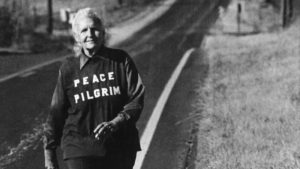
For 28 years, Peace Pilgrim walked across the US and Canada, covering thousands of miles, carrying the message of peace. All through those years, she never used money. She wore the same navy blue slacks and shirt, tennis shoes and a self-designed navy blue tunic with pockets all around the bottom in which she carried her only possessions: a comb, a folding toothbrush, a pen and her small blue leaflets to pass out on the way. That was all.
Born Mildred Lisette Norman on July 18, 1908, her inner compass slowly moved toward seeking a greater purpose. Following an unhappy marriage, she embarked on a personal transition that culminated with her hiking the 2050-mile Appalachian Trail – the first woman to do so in one season. On this journey, she had a vision that guided the rest of her life.
Walking for peace
Peace Pilgrim began her peace walk on New Year’s Day in 1953. She later said, “… it was the proper time for a pilgrim to step forth. The war in Korea was raging and the McCarthy era was at its height… There was a great fear at that time and it was safest to be apathetic. Yes, it was most certainly a time for a pilgrim to step forward, because a pilgrim’s job is to rouse people from apathy and make them think.”
She carried with her three peace petitions: one requesting immediate peace in Korea, one pleading for the establishment of a national Peace Department, and the third, directed to the UN, seeking total disarmament and, in its place, the furthering of world prosperity. Signatures for these petitions that she and others collected were presented to the White House and the UN upon her arrival in the East Coast 11 months later.
She didn’t stop there. She kept on walking, criss-crossing the US six times, walking for the rest of her life. On the front of her tunic were the letters, PEACE PILGRIM, and on the back was: WALKING COAST TO COAST FOR PEACE, and later, 25,000 MILES ON FOOT FOR PEACE. This was her outfit for the rest of her life, with new clothes being brought for her and new letters sewn on by friends as the old ones wore out.
She moved north in the summer and south in the winter to take advantage of the weather. After the first 25,000 miles she stopped counting. Contrary to the tradition of the Buddhist monk with his begging bowl, she did not ask for anything. She went without food until it was offered to her or she found it in the wild. She slept wherever she could, such as a bus station or a cornfield, if no one offered her a place to sleep. “I seldom miss more than four meals in a row,” she told her many audiences. Early on, she left even her name behind when her sister’s family began to be bothered by the FBI, who suspected that this peace walker was a communist! She wanted to spare them harassment.
Peace in the world and peace within
To all who would listen she talked about the vital need for peace and the practical things that anyone could do to work for peace – peace in the world and peace within, which she recognized as interwoven. As a pilgrim, she would tell very little of her life as Mildred – not her name, age, or where she lived. When asked, “Why not?” by a college student, she answered, ”I would much rather they remember the important things instead of the very unimportant thing.” Her focus was on her mission to further the cause of peace, and to inspire those who “want to do more growing.”
Peace Pilgrim died on July 7, 1981. The woman who had spent her life walking through every state and most of Canada lost her life riding in a car on her way to a speaking engagement.
Afterword: Friends of Peace Pilgrim is a non-profit, all-volunteer organization devoted to spreading Peace Pilgrim’s message. On their website you can find more information on her and can also download the free ebook Peace Pilgrim: Her Life and Work in Her Own Words. A documentary on her life is available here.

Every blog written is triggering enthusiasm and drives a purpose for life…
Would have never known about such brave and purposeful women if not for your post Sir.
What a feat. We see some people taking the unbeaten paths. Its more for personal solace rather than for any public consumption and praise. Not many can do it. It requires conviction and grit to disown materialistic comforts for a public cause. The initial moments are herculean no doubt, but the sense of purpose and the public good that some actions can bring about often outweighs all personal discomforts and it becomes a way of life. This requires action, from us as individuals, and it should be now and never afterwards. I believe that some of these calls come without a choice and it is for us to pick it up.
What an inspiring story. Thanks Dr. RR for sharing these wonderful collections of yours. Will eagerly look forward, every day, to your postings.
I had heard the term before and never linked it to her story. Thank you for shining a light! What an inspiring woman!/Human – her legacy still lives –
A very powerful story/life-story. What was amazing was her faith and she just let go – soon things just fell into place. Have always felt that the rules that govern nature are not the ones that we learn in our society. Like when we let go, whatever we need comes to us rather than when we go after things. Of course, in both cases, we might get what we want but the former is so effortless – like the way it happens in nature 🙂
Beautiful story. Incredible faith and dedication!